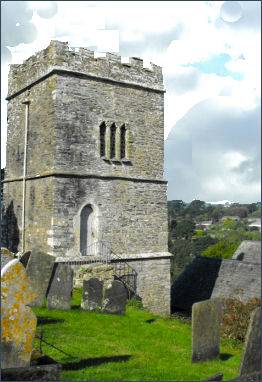Talland
OS Grid ref:- SX 2251
 The small hamlet of Talland in southeast Cornwall is situated on the coast of Talland Bay between the villages of Looe and Polperro and is surrounded by beautiful cliff scenery.
The small hamlet of Talland in southeast Cornwall is situated on the coast of Talland Bay between the villages of Looe and Polperro and is surrounded by beautiful cliff scenery.
The village's name is probably derived from tal-lann, meaning a 'hill-brow church site'.
The village church is dedicated to St Tallanus, which stands dramatically at the cliff-top, is dedicated to St Tallanus. St Tallanus is said to be a hermit who made his home here sometime in the fifth century, the site has been a sacred place since Celtic times. The altar of the present-day church is situated on the site of the original Celtic altar, said to date from the time of Tallanus.
Unusually the church has a detached bell-tower on the south side which was joined to the main body of the church in the fifteenth century. There survives old woodwork in its fine wagon roofs; and the many bench ends (partly circa 1520, with the rest dating to circa 1600) are of the usual Cornish type and among the finest examples of these.
 Part of the nave and the first stage of the tower probably remain from a thirteenth century church, the remainder, in the
Cornish Perpendicular style, probably dates to the late fifteenth century. The building has fine wagon roofs, the benchends date partly to circa 1520 and the remainder circa 1600.
Part of the nave and the first stage of the tower probably remain from a thirteenth century church, the remainder, in the
Cornish Perpendicular style, probably dates to the late fifteenth century. The building has fine wagon roofs, the benchends date partly to circa 1520 and the remainder circa 1600.
Near the door of the church in the south west corner is the headstone of Robert Mark who was killed in 1802. Local legends differ about Robert Mark's identity. One version relates that Mark was on a smuggling trip when he died from wounds inflicted by a cannon ball. This is borne out both by the details on the tombstone, and by the fact that a smuggler of the same name was sentenced in May 1799 for resisting arrest when the smuggling vessel Lottery was captured. However, another account makes him not a free-trader but a revenue man who was shot in a cellar on dry land; Jonah Puckey, the ringleader of a smuggling gang, reputedly fired the shot that killed him. The inscription reads:-
"ROBERT MARK late of Polperro, who Unfortunately was shot at Sea the 24th day of Jany in the year of our Lord GOD 1802, in the 40th Year of His AGE"
A sword in the nearby Polperro Museum of Smuggling and Fishing, on loan from the Royal Armouries, at the National Museum of Arms and Armour in Leeds. is Robert Mark, the sword dates from 1789.
Talland Bay was once well known as a landing spot for smugglers and the village has its share of smuggling stories. Talland was perhaps best known for its vicar from 1713–47, the Revd Richard Dodge. He was reported to have been quite an eccentric character and had built up a fearsome reputation as an exorcist, who could summon evil spirits and caste them out and went out at night to round up the spirits on the highway. He was often observed leaping around the churchyard at night, cracking a whip around the headstones to drive away evil spirits. However it appears that Dodge's night time theatricals were a cover for a large smuggling operation the parson ran, thought to be in league with the Polperro smugglers. The people of Talland feared walking towards the church after darkness fell, thus allowing him Dodge carry out his illicit activities and smuggle his contraband without fear of being observed.